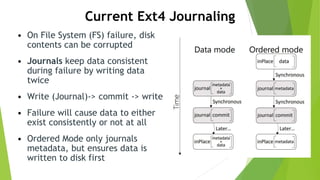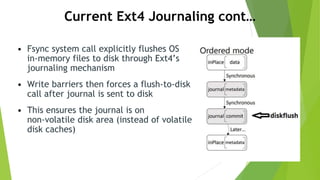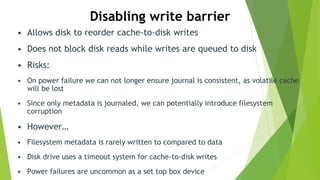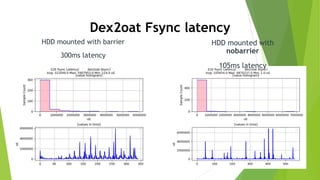Ext4 write barrier
- 2. Current Ext4 Journaling âĒ On File System (FS) failure, disk contents can be corrupted âĒ Journals keep data consistent during failure by writing data twice âĒ Write (Journal)-> commit -> write âĒ Failure will cause data to either exist consistently or not at all âĒ Ordered Mode only journals metadata, but ensures data is written to disk first
- 3. Current Ext4 Journaling contâĶ âĒ Sometimes, we do not need to journal the data, only the metadata: ie. data corruption is OK, breaking the directory tree is not OK âĒ Ordered Mode is default, reduces the amount of double writing, but allows data corruption. âĒ Data mode is very slow âĒ Unordered mode exists, but is much more dangerous
- 4. Current Ext4 Journaling contâĶ âĒ Fsync system call explicitly flushes OS in-memory files to disk through Ext4âs journaling mechanism âĒ Write barriers then forces a flush-to-disk call after journal is sent to disk âĒ This ensures the journal is on non-volatile disk area (instead of volatile disk caches)
- 5. PROBLEM âĒ After OTA, SSHD NAND cache is filled with OTA data âĒ Dex2oat does ahead-of-time compilation for Android apps âĒ Dex2oat calls fdatasync (similar to fsync) at regular intervals, causing disk flushes âĒ Since NAND is full, every fsync causes all dirty data on SSHD Cache (upto 64MB) to be flushed to platter âĒ Fsync therefor causes a synchronous IO block, preempting any other disk reads and writes âĒ Causes huge amount of sluggishness at user experience side
- 6. Disabling write barrier âĒ Allows disk to reorder cache-to-disk writes âĒ Does not block disk reads while writes are queued to disk âĒ Risks: âĒ On power failure we can not longer ensure journal is consistent, as volatile cache will be lost âĒ Since only metadata is journaled, we can potentially introduce filesystem corruption âĒ HoweverâĶ âĒ Filesystem metadata is rarely written to compared to data âĒ Disk drive uses a timeout system for cache-to-disk writes âĒ Power failures are uncommon as a set top box device
- 7. Dex2oat Fsync latency HDD mounted with barrier 300ms latency HDD mounted with nobarrier 105ms latency
- 8. Androbench SQLite HDD mounted with barrier Transactions Per Second (TPS) HDD mounted with nobarrier Transactions Per Second (TPS)
- 9. SQLite Fsync latency EMMC mounted with barrier 860us latency EMMC mounted with nobarrier 361us latency
- 10. Androbench SQLite EMMC mounted with barrier Transactions Per Second (TPS) EMMC mounted with nobarrier Transactions Per Second (TPS)










